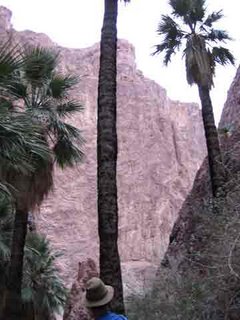We made it to the oasis and back, narry a mirage stifled the way, although the wind blew its best, trying to whip us, still we persevered.

he's SWSBM class of 2006 wandering thru the desert, the botanizing fools!

here's a classic scene of the man at work -- the camp chair on the pavement. Usually all of us are gathered around him like kids at story hour. He zips around on a little scooter so we stuck to the packed earth and paved roads for lectures and meandered off over the hills on our own when we was finished lecturing...

We drove east down highway 8, back into AZ, after a week of camping in the Anza-Borego Desert in Southern California. We had a great time getting to know our classmates better and checking out the real oases of the desert. We hiked to a couple different groves of desert palms out in the unbelievable desert. Today we stopped in a place called Dateland, for a famous date shake, which was unbelievably good, and unbelievably sweet at the same time; glycemic index 12,000. There is a crazy date plantation there where they hand pollinate all the date palms with their 5 foot flowers!
Yesterday we saw a beat up old bus driving slowly down the highway; we thought to ourselves, who could be inside such a vehicle, another traveling hippie circus, a church youth group? No, it was packed to the brim with aging Mexican males. Where could such a busload of people be traveling so close to the border under the watchful eye of the omnipresent border Patrol? Today we saw their destination. Highway bound we headed out from the Kofa mountains: volcanic teeth of red, rhyolite rock with a hidden grove of California Fan palms and hummingbirds high in their crevices. We began to the pass the 100s of acres of vegetable fields at rest we had passed on the way in Sunday afternoon. This time the fields were alive with workers, the ones bused in daily from Mexico. The same beat up buses with government signs on the sides denotes the program that allows campsinos to labor for the day, week, etc. in the American agribusiness. Literally hundred of men and women were hand picking and packaging lettuce, cabbage and lemons and loading the “Foxy” Brand boxes on to huge flat bed trailers. This was barely 9AM and they had a third of the 18-wheeler already stacked and strapped down with boxes. It just seemed crazy, that here at the end of the Colorado river, that the last vestiges of that mighty force could be diverted to the flood irrigation we saw happening. Water flooded and pooled on the sides of the road, while the river dwindled to a creek before it entered into Mexico. Not much of the mighty force that carved ye ole Grand Canyon resonates here.

a bad picture with no people. but you get the idea.
3-28
Last night we stayed in the Saguaro Cactus National Monument….we slept in a field of the squbby, chubby and mostly just plain tall icons of this state. It’s like a dream waking up every morning when the sun comes up and deciding where to go next, just rolling down the roads in the old honey wagon stopping at places that interest us. Every night we stay in some new nook of this state. We love having everything we need right here in the car, cooking the best food on mom and dad’s old Coleman stove and snuggling down on the, now classic, futon mattress.


Camp
Two days ago on the way to the Kofa Mountains (a witty little contraction made from “King of Arizona” mine) at yet another random border patrol stop, the congenial guard told us to watch out for stray military parts and unexploded bombs – great. I told him that if he saw us the next morning, that would mean we didn’t get blown up. Little did we know that where as the map might call a land mass a “wilderness reserve” the military sees things differently. The “Yuma Proving Grounds” are a delightful little parcel of thousands of acres of tank staging ground. General Paton also used the area in during the first WW, to test all kinds of old school stuff – lucky us.

Kofa Mountains Palm Oasis -- the palms have "retreated" into a canyon deep inside this mountain over the last few hundred years of drought....
Well, we just passed the Best Western Space Age Lodge, an eccentric little place all decked out with a Sputnik theme…I think its time to move on.





















